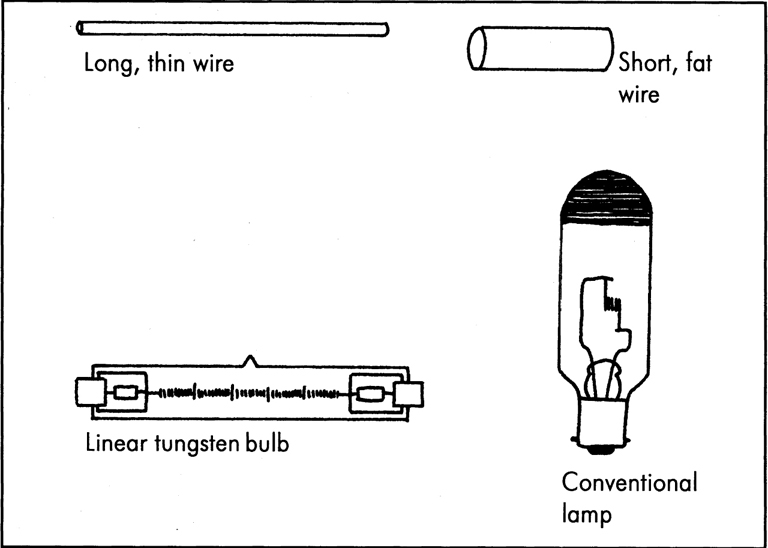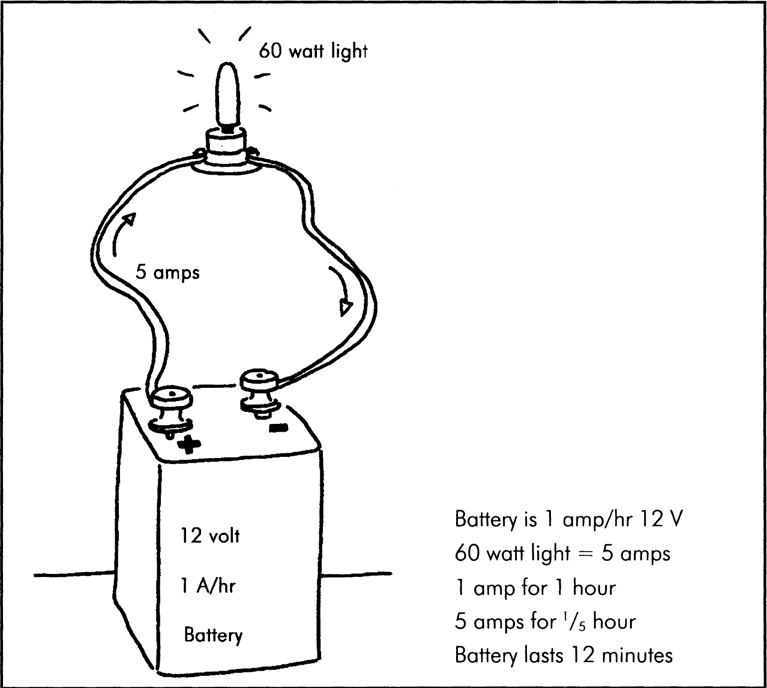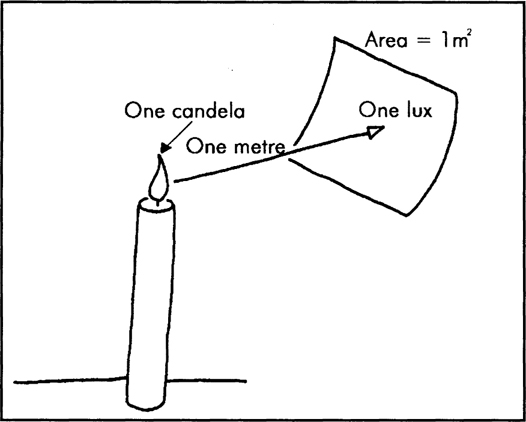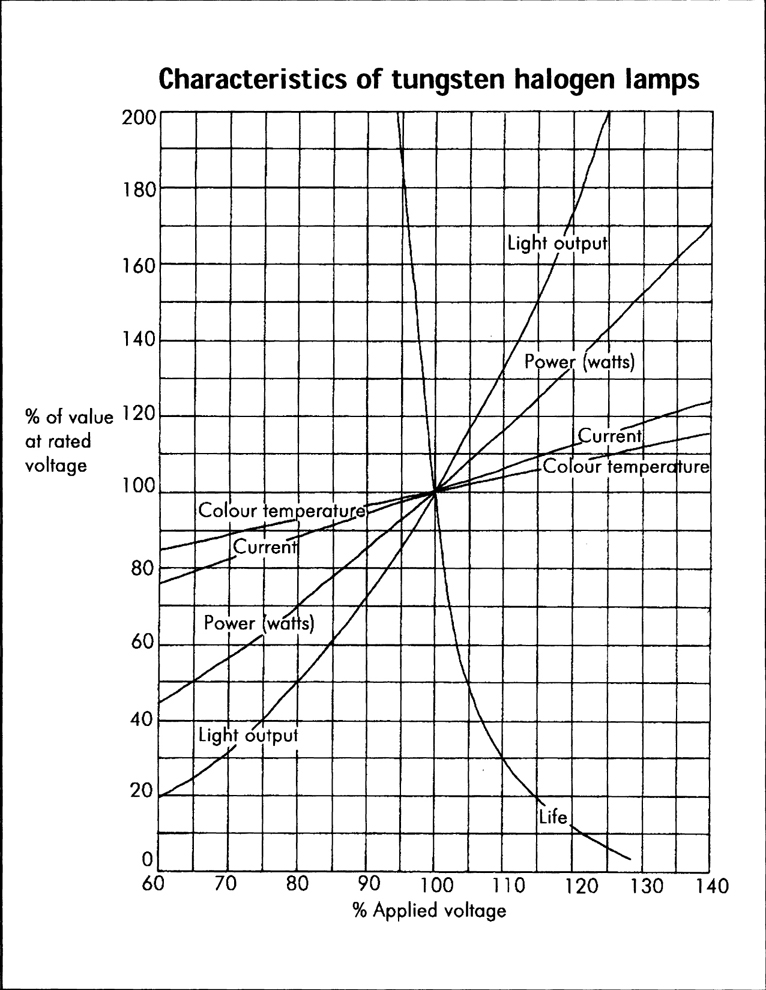2 A little electricity
A little basic grounding in electricity will help in understanding why artificial lights are rated in watts. A voltage, from the mains or a battery, supplies the pressure to cause electrons, in the form of an electric current, to move around. How many electrons move is dependent on how much resistance is offered to their movement. All metals have a resistance which can be controlled by altering their length or diameter (Figure 2.1). The metal in a bulb is in the form of a piece of wire – the element – which may be straight or coiled to achieve the required length to fit within the glass bulb.
Figure 2.1 The resistance of a piece of wire is determined by the material it is made from, the cross-sectional area of the material, the length and the temperature of the material. The thin, long wire will have the same resistance as a proportionately fatter, shorter wire. When used in artificial lights the filament may be long and coiled up to fit into a smaller space or it may be one length, resulting in a longer bulb. Thicker wire has less resistance and so produces less heat and light for a given length. In practice lamps are optimized to give the highest possible lumens to watt ratio. Filament diameter and length is selected for optimum light output and mechanical strength

Ohm’s law gives the mathematical formula to find the voltage, or current, or resistance from the other two (Figure 2.2). It is expressed as V = IR where V is the voltage, I is the current (in amps) and R is the resistance (in ohms). The formula is easily transposed into I=V/R or R= V/I. The current (I) in amps is very important because fuses are measured in current carrying ability (5 A, 13 A, 15 A, etc.).
Figure 2.2 Ohm’s Law allows us to find the current taken by a light (I measured in amps) by calculation from the voltage (V measured in volts) and the resistance (R measured in ohms). Although the basic formula is V=IR, it can be transposed to give I=V/R or R=V/I

The fuse protects the equipment from possible damage, or fire, and must be rated at just above the current required by the light being used. The electrical cable supplying the light has a current carrying capability of its own and must not be forced to take more, the correct fuse rating protects the cable as much as the light. It is, therefore, very dangerous to fit a bulb needing more current than the light is manufactured to use.
Another formula is used to find the power of the light in watts. If the voltage is multiplied by the current the result is expressed in watts, so W= VI. In the example (Figure 2.3) it can be seen that our light with a coil resistance of 60 ohms giving a current of 4 amps when connected to the mains of 240 volts results in a power rating of 960 watts (to all intents and purposes a 1000 watt or 1 kilowatt light).
Figure 2.3 The power rating of a lamp is measured in watts (W). To find the watts we first need the volts (V) and the current (I). The basic formula is W=V*I, but, again it can be transposed to find a missing value from the other two. To find the voltage the formula would become V=W/I and to find the current I=W/V

The fact that lights are quoted in watts is not much help. We need to know the current taken, to work out the fuse rating, and the voltage, so that we use exactly the right amount of electrical pressure. ‘Mains voltage’ lights could be 220 volts or 110 volts, different countries use different mains voltages. Some lights use a bulb of one voltage and then a transformer to alter the mains voltage to the correct value.
A 1 kilowatt bulb can be fitted into a variety of lanterns with different reflecting or focusing devices to produce differing amounts of light output. The only thing that you can be certain of is that there is not a linear relationship between watts and actual light output. A 2 kilowatt light will not produce twice the output of light as a 1 kilowatt light.
Knowing the wattage of a bulb is an indication of how powerful the light is but it is not the whole story. You will see in the next section that the actual light output should be considered in other ways which relate to their ability to provide enough light for the scene.
The electrical values of voltage, current and watts are given to help you choose the power rating of connecting cables, fuses and use the correct voltage. It is only too easy to go on a location shoot with three 2 kilowatt lamps and plug them all into a domestic mains socket. The resulting overload of current will at best blow a fuse and at worst start an electrical fire.
If lights are being powered by batteries it is more important to know the amps the light will need. Batteries are quoted not only in voltage, but in amp/hours. This is a measure of how many amps a battery can supply for how long. It is essential on location that this is calculated. Figure 2.4 shows the relationship of a 5 amp light connected to a 1 amp/hour and a 5 amp/hour battery.
Figure 2.4 Here a 12 volt light, taking 5 amps, is connected to a 12 volt battery. The battery is rated at 1 amp/hour. This means it will give 1 amp for 1 hour, before it needs re-charging, or, with this light connected to it, 5 amps for a fifth of an hour (12 minutes). If the battery was rated at 5 amp/hour then it would give 5 amp for 1 hour and our light would last for 1 hour before the battery went flat

A little physics
Light travels in straight lines and spreads outwards from its source in all directions. Lantern manufacturers control this output by altering the spread (beam width) and offering various focusing systems to make the light sharp (focused) or soft (diffuse). It is not sufficient, therefore, to know that we are using a 1 kilowatt bulb. It tells us nothing about how much light is available. All we know about a 1 kilowatt bulb is that it will take approximately 4 amps of current at 240 volts.
A simple example of how little the power (in watts) of a particular bulb helps would be to think of a car headlight. When switched to dipped beam it is designed to illuminate a large area immediately in front of the car but, when switched to main beam, the same wattage bulb will illuminate a much narrower area further away from the front of the car.
What we really want is a measure of the brightness of one light compared with another. The brightness of a particular light is most usefully described by considering its light output, not its power rating. In 1948 an international standard was adopted to measure this luminous intensity against a known scale. The unit chosen for measurement was the candela (cd). If a one candela source radiates uniformly in all directions the amount of luminous flux falling within a unit solid angle is called a lumen (lm). Most manufacturers will quote their bulbs as having a certain number of lumens per watt. This gives us an indication of how bright one bulb is against another. For example, a xenon lamp is ‘brighter’ than a standard tungsten lamp of the same wattage.
Once we put these bulbs into lanterns and start to control the beam of the light we need another comparison. We need to consider the light energy that arrives at its destination. The unit we use for this is the lux (lx). The lux is the illumination produced on a surface by one lumen of light per square metre (Figure 2.5).
Figure 2.5 Shows the relationship between candela and lux. If a manufacturer quotes a light output in lumens per watt the total output will be lumens per watt figure multiplied by watts. The total lux can then be worked out by using the formula multiplied by watts. The total lux can then be worked out by using the formula lux = lumens/area (in square metres)

This might all seem very complicated but it is necessary for you to have a basic understanding of the terms that you will come across. You will find that camcorder specifications state a minimum lux level that they need to work with. Using this level will give an image of sorts but you will need considerably more to achieve an acceptable picture that gives you good definition, no picture noise (which shows up as broken patterns rather like snow) and good colour definition. It would be more realistic for manufacturers to say you will see an image with 1 lux but it won’t be acceptable until you use 15 lux.
Typical light levels that you will meet naturally include living rooms (75–250 lux), sunrise (0–150 lux) and bright sunlight (50,000–1000,000 lux). It is easy, now, to see why we more often than not supplement lighting on location. The best video pictures come from an overall high light level with subtle variations to suggest ‘dark’ or ‘bright’ corners. The camera aperture can always be shut down to control the light level whilst retaining a depth of focus that will produce the third dimension effect that makes a subject stand out from the background.
There is a very complex relationship between the voltage applied to the light, the current it takes (hence the watts), the colour temperature and the life of the bulb (Figure 2.6). A very small reduction in the applied voltage will have a negligible effect on colour temperature and could double the life of the bulb for very little loss of light output.
Figure 2.6 There is a quite simple relationship between an increase, or decrease, in voltage applied to a light which affects the current and its actual output and life expectancy. You can see that an increase in voltage from 240 v to 252 v (5%) results in 20% more light at the expense of 50% of its life. If we ran the lamp at 228 v (a reduction of 5%), we would get slightly less than a 20% loss in light but increase its life by 100%

The studio lighting team needs to be aware of this relationship because all dimmer circuits reduce the lamp output by altering the voltage or current supplied to it. This in turn reduces the wattage and the lamp becomes less bright. Once the light output falls so does the colour temperature. This will affect the overall coloration of the picture. There must, therefore, be a ‘starting’ point at which the lamp is being used as efficiently as possible with regard to its life expectancy and then the cameras can be white balanced. Small reductions in level will produce the desired visual effect without too noticeable a colour change. If the scene needs to fade out this is done on the vision mixer rather than in the theatre where the lights are faded out.
When a tungsten light is burning the tungsten filament starts to evaporate. This condenses on the cool parts of the bulb and forms a black layer. This, in turn, raises the temperature of the bulb and eventually moisture forms. The oxygen in the moisture attacks the filament and forms tungsten oxide which causes more blackening, repeating the cycle until the bulb is almost completely black and the filament melts (bulb blows). Most modern lamps include a halogen in the bulb (chlorine, iodine or bromine) which reacts with the tungsten to provide a transparent substance. While this prevents blackening the filament still becomes thinner and consequently melts.
To extend the life of a bulb, it has been discovered that if the bulb wall is kept above about 250°C the tungsten halide is carried back to the filament, allowing the tungsten to re-form. Because the tungsten cannot be guaranteed to re-form at exactly the place from which it was lost, there will eventually be a weakening of the filament causing the bulb to blow.
In order to sustain the high bulb temperatures, large glass areas have been replaced by small quartz envelopes. This is the reason that modern lamps are small and known as quartz halogen bulbs.
Cleanliness is a very important factor in the replacement and handling of quartz lamps. The smallest amount of sodium (found in finger marks) will destroy the quartz, damaging the optical quality and shortening the life of the bulb.
Bromine filled lights are not suitable for use with dimmer circuits because the reduction in power, causing a reduction in envelope heat, causes the bromine to corrode the tungsten causing shortened life.
The filaments of modern lights, particularly high power lights, are very thin and run at extremely high temperatures. Care should be taken to protect them when hot, as any sudden jolting will fracture the filament. When the lights are finished with, they should be switched off before any other equipment and allowed to cool down properly before being moved.
Low voltage lights, run from batteries, are very suitable for location work for several reasons. The disadvantage of the voltage being lower and therefore the current being higher, for a given wattage (W = VI), means that the filament will have to be thicker and smaller. A thicker filament will have a longer life and be more resistant to movement. Because the bulb is smaller it is possible to fit the bulb inside a mirror to give a more powerful and concentrated light output (Figure 2.7). In practice a 100 watt low voltage (12 volt) light will have approximately the same output as a 500 watt (240 volt) light.
Figure 2.7 This is the size relationship between a standard tungsten lamp, the smaller QI (quartz halogen) equivalent and a QI fitted into its integral mirror. These mirrors are known as dichroic because although light is reflected forwards from the mirror, the infra red (heat) rays pass through the back of the mirror. This can reduce the heat from the front of the light by as much as 70%

